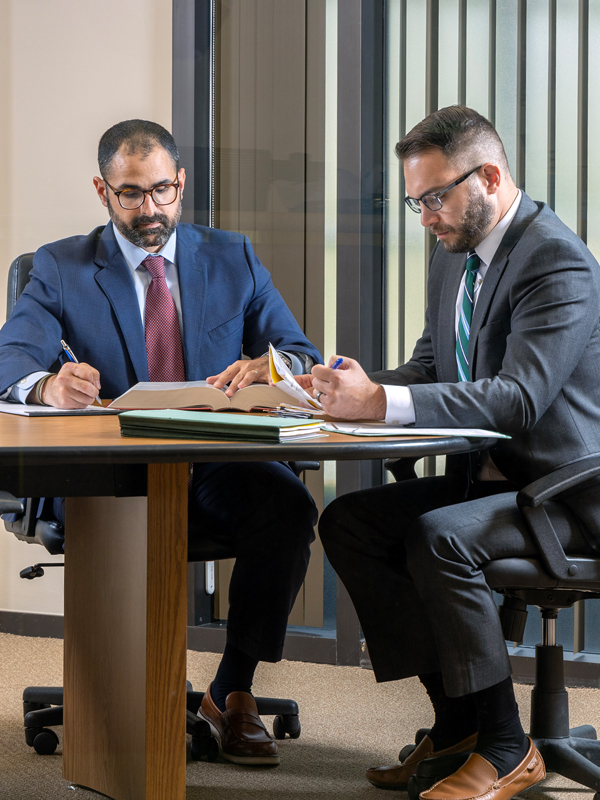- Free Consultation - Call 24/7: (603) 883-4100 What's My Case Worth?
Jury Selection Process
Granite Law Group managing partner, Joseph J. Russo, was recently selected as one of the presenters at the jury selection process seminar entitled “Voir Dire Toolbox.” The event was put on by Massachusetts Continuing Legal Education (MCLE). MCLE | New England: CLE Programs, Webcasts and Publications The legal term “voir dire” is synonymous with jury selection and translates to “speak the truth” in Old French.
The event was moderated by Michael Conley, a well-respected trial attorney at Kenny & Conley. Personal Injury Attorneys Braintree, MA | Home | Kenney & Conley (kenneyconley.com) The panel consisted of trial attorneys who had experience picking juries across multiple jurisdictions. These included Massachusetts, New Hampshire, Connecticut, and New York.
Primarily, the seminar addressed arguments for and against Panel Voir Dire. The process is relatively new to Massachusetts but is common practice in New Hampshire. Panel Voir Dire was authorized by Massachusetts Superior Court Rule 6 in 2015 and has since been codified under M.G.L. 234A § 67A. A thorough reading of these two laws should be undertaken.
Superior Court Rule 6: Jury selection | Mass.gov
General Law – Part III, Title II, Chapter 234A, Section 67A (malegislature.gov)

Panel Voir Dire Process:
The jury selection process for Panel Voir Dire involves sitting approximately 20 – 24 potential jurors in the jury box. Each side is then given approximately 20 minutes to pose questions to the entire panel. In a civil Superior Court case, each side is permitted an unlimited number of challenges “for cause” (if the juror simply cannot be fair and impartial) and 4 “pre-emptory” challenges (for any reason). If a juror is not challenged, they are seated on the jury until 12 jurors are selected with an additional 1-2 alternates.
In a Massachusetts Superior Court civil case, there must be a verdict of at least 10 out of 12 jurors. The plaintiff’s burden of proof is “by a preponderance of the evidence.” In a Massachusetts Superior Court criminal case, there must be a unanimous verdict of 12 out of 12 jurors. The prosecutor’s burden of proof is “beyond a reasonable doubt.” The legal definition of “by a preponderance of the evidence” is “more likely than not.” This is a lower standard than “beyond a reasonable doubt.”
According to Rule 6, Panel Voir Dire can only occur if the proponent files a pre-trial motion in limine. Judges are given broad discretion to oversee the mechanics of Panel Voir Dire and what lines of questioning are permissible.
The jury selection process for Panel Voir Dire is markedly different than individual conducted voir dire. Individual conducted voir dire involves asking each individual juror questions at sidebar (up by the judge’s bench). The theory is that jurors are going to be more forthcoming if they’re given some privacy to express their opinions.
Pros and Cons:
So what are the arguments for and against Panel Voir Dire? Proponents of this jury selection process point to the attorney’s ability to build rapport with the potential jurors. This is done through the facilitation of a group discussion. Once the more vocal jurors begin sharing their opinions, the group begins to loosen up. This lends itself to a more open discussion. The attorney can also piggyback off the more opinionated answers and ask other jurors if they agree or disagree. Finally, the process is much quicker and more efficient. Typically, the jury will be selected by the end of the morning court session.
Critics of the process point to the risk that a potential juror will blurt out an answer that is wildly biased. This could poison the opinions of the other jurors. Some judges are reticent to allow an inexperienced attorney to conduct Panel Voir Dire because they might ask an inappropriate question. This could poison the jury as well. An example would be if the attorney starts discussing the facts of their case to indoctrinate the jurors before the evidence comes out.
Panelist Consensus:
The panelists responded to these concerns. They agreed that the utility of knowing which jurors hold biased opinions outweighs the risk of the other jurors being influenced by a rogue answer. The panelists determined that no one is likely to have their opinion changed in the moment. Moreover, there is nothing that the opinionated jurors were going to say in jury selection that they would not say during deliberations. So, it was better to know who was going to be dangerous to their case upfront.
The panel also discussed that it was important to see the potential jurors interact as a group. Who was going to be a leader, follower, or contrarian? These archetypes are easier to spot during a group discussion.
Ultimately, the presenters agreed that Panel Voir Dire is the preferred jury selection process. They encouraged their peers to pursue the process so it becomes normalized within the judiciary.
General Law – Part III, Title II, Chapter 234A, Section 67B (malegislature.gov)
General Law – Part III, Title II, Chapter 234A, Section 67D (malegislature.gov)
/blog/civil-justice-system-under-attack/
/blog/joseph-russo-selected-to-naopias-top-10-under-40/
/blog/joe-russo-presents-at-nhaj-personal-injury-fall-forum/











